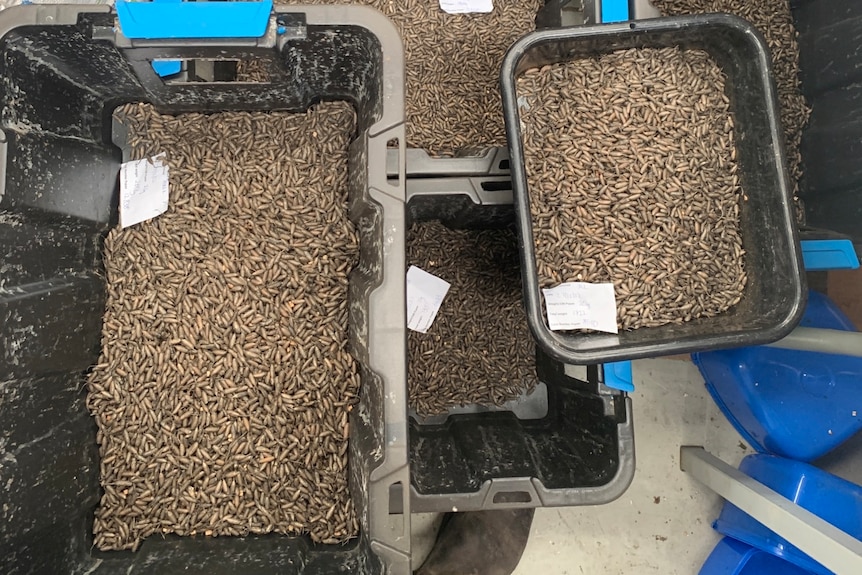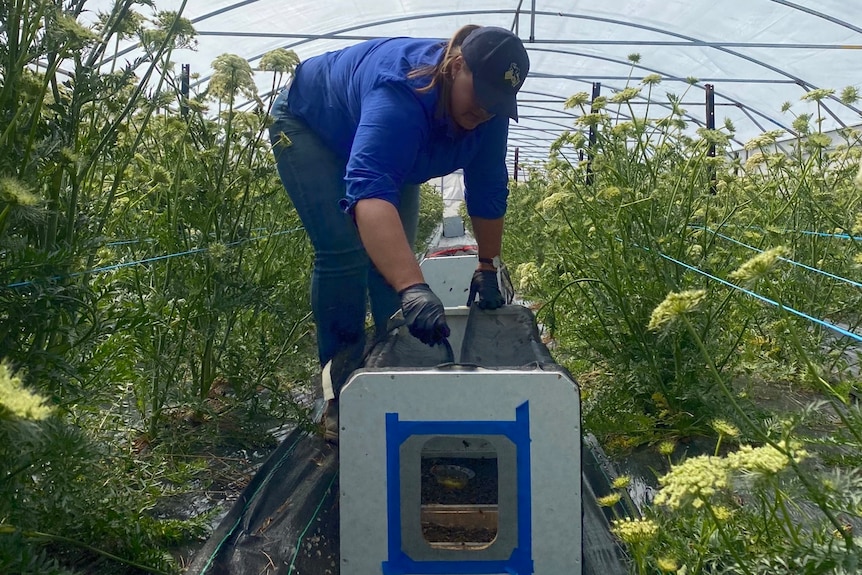- In short: As bees face threats like varroa mites, a fly is proving its pollination skills.
- They don't sting, don't bite and don't have a hive, instead, they nest around the foliage of crops.
- What's next? A Tasmanian company is sending out 2 million hover flies to pollinate carrot crops this summer to prove their commercial use.
As threats to Australia's bee population increase, including from varroa mites, a fly is emerging as a top alternative pollinator.
Hover flies look a little like bees — they're about the same size, but they don't sting, so they're arguably easier to work with.
They eat nectar and pollen and their hairy bodies transfer pollen from flower to flower.
But unlike bees, hover flies don't go back to a hive. They stay on the crop, nesting in and around the foliage of the plants.
This means they're not at risk of varroa mite infestation, as the mites feed and complete their lifestyle on adult bees in the hive.
In the field environment, hover flies live about four to five weeks.
This December, the pollinator alternative will be tested on commercial carrot crops in Tasmania.
"We're building up our population to hit a target in December, which will be about 2 million flies going out doing around 10 per cent of our crops," Mick Palmer, from Tasmanian Pollination Services, said.
He is confident hover flies will do as good a job as bees.
The flies will work in tandem with bees on the crops but could end up usurping bees, particularly as disease pressure on bees grows.
"We've proven through research that these flies work well in open fields of carrots, so this is where we are just pushing out the commercialisation," Mr Palmer said.

Tasmanian Pollination Services is confident hover flies will be the perfect backup to bees and could even replace them in an emergency.
"Moving forward, the flies will be used as insurance, if you like, so if varroa [mites] come to Tasmania, we may have to do 100 per cent germination with the flies," he said.
Hover flies pollinate as well as bees, researcher says
Dr Raylea Rowbottom has been researching hover flies as alternative pollinators for the past seven years.
She said research showed they pollinated as well as bees and could work on the same flower at the same time.
"It's a very timely project … it's due time for us to have another managed pollinator alongside bees that we can use," she added.
Hannah Allwright from South Pacific Seeds agrees; her company has also been involved in the hover fly's research.
She fears what may happen if the varroa mite arrives on Tasmania's shores, something beekeepers fear will happen, particularly now that Australia has moved from an eradication policy to management.
 Hannah Allwright from South Pacific Seeds working inside one of its research polytunnels in southern Tasmania.(Supplied: Annick Upchurch)
Hannah Allwright from South Pacific Seeds working inside one of its research polytunnels in southern Tasmania.(Supplied: Annick Upchurch)
"There's going to be big areas where we're not going to be allowed to move bees around, so having a backup up our sleeve is going to be really important," she said.
They could be a game changer for the professional pollinator industry.
"They are very friendly, they'll quite often come and hover in front of your face or land on you and check you out and they don't sting, they can't bite," Dr Rowbottom said.
"In environments such as covered cropping, they're a lot safer for people to work around," she said.
"They can do exactly the same amount of pollination in the system that we've tested so far, as the bees do."
The work in Tasmania is part of a $6.4 million pollination project led by Hort Innovation Australia, several Australian Universities and research groups, including Seed Purity.
"There are the states involved in this research and there are other flies that prefer warmer climates that we will be looking at in the future," Dr Rowbottom said.
For Tasmanian Pollination Services, though, it is crunch time. December is the big test and everyone is holding their collective breath, with 2 million flies being sent out onto crops.
"Moving out of research and into commercialisation, we're not sure exactly what the future holds, we make assumptions, and we test them and fail all the time, but we're getting better and better," Mick Palmer said.
"We've proven them on an open field with carrots, and we know that they'll do the job for us."